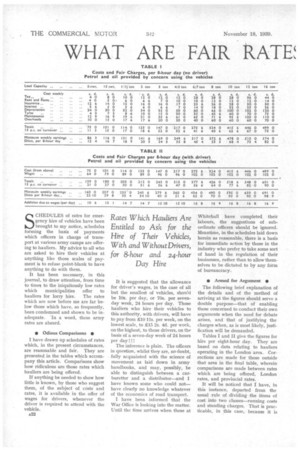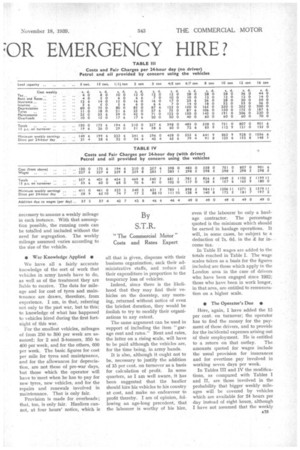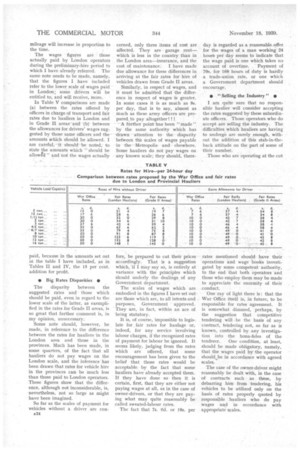WHAT ARE FAIR RATE OR EMERGENCY HIRE?
Page 24

Page 25

Page 26

If you've noticed an error in this article please click here to report it so we can fix it.
Rates Which Hauliers Are Entitled to Ask for the Hire of Their Vehicles, With and Without Drivers, for 8-hour and 24-hour
Day Hire By S.T.R.
"The Commercial Motor" Costs and Rates Expert SCHEDULES of rates for emergency hire of vehicles have been brought to my notice, schedules forming the basis of payments which officers in charge of transport at various army camps are offering to hauliers. My advice to all who are asked to hire their vehicles at anything like those scales of payment is to refuse point-blank to have anything to do with them.
It has been necessary, in this journal, to draw attention, from time to time to the iniquitously low rates which municipalities offer to hauliers for lorry hire. The rates which are now before me are far below those which have, so frequently, been condemned and shown to be inadequate. in a word, these army rates are absurd.
• Odious Comparisons • I have drawn up schedules of rates which, in the present circumstances, are reasonable and fair. They are presented in the tables which accompany this article. Comparisons show how ridiculous are those rates which hauliers are being offered.
If anything be needed to show how little is known, by those who suggest them, of the subject of casts and rates, it is available in the offer of wages for drivers, whenever the driver is required to attend with the vehicle.
A22 It is suggested that the allowance for driver's wages, in the case of all but the smallest of vehicles, shonkl be 10s. per day, or 70s. per sevenday week, 24 hours per day. Those hauliers who hire their vehicles to this authority, with drivers, will have to pay from £10 1Is, per week, on the lowest scale, to £15 2s. 4d. per week, on the highest, to those drivers, on the basis of a seven-day week of 24 hours per day U!
The inference is plain. The officers in question, whilst they are, no doubt, fully acquainted with the science of movement as hid down in army handbooks, and may, possibly, be able to distinguish between a carburetter and a distributor—and I have known some who could not— have clearly no knowledge whatever of the economics of road transport.
I have been informed that the War Office is looking into the matter. Until the time arrives when those at Whitehall have completed their labours, the suggestions of subordinate officers should be ignored. Meantime, in the schedules laid down herein as reasonable, there is a basis for immediate action by those in the industry who prefer to take some sort of hand in the regulation of their businesses, rather than to allow themselves to be dictated to by any form of bureaucracy.
• Armed for Argument •
The following brief explanation of the details and of the method of arriving at the figures should serve a double purpose—that of enabling those concerned to conduct their own arguments when the need for debate arises, and that of justifying the charges when, as is most likely, justification will be demanded.
Tables I and II give the figures for hire per eight-hour day. They are based on data relating to hauliers operating in the London area. Corrections are made for those outside that area in the final table, wherein comparisons are made between rates which are being offered, London rates, and provincial rates.
It will be noticed that I have, in this instance, departed from the usual rule of dividing the items of cost into two classes—running costs and standing charges. That is practicable, in this case, because it is necessary to assume a weekly mileage in each instance. With that assumption possible, the running costs can be totalled and included without the need for segregation. The weekly mileage assumed varies according to the size of the vehicle.
• War Knowledge Applied • We have all a fairly accurate knowledge of the sort of work that vehicles in army hands have to do, as well as of the treatment they are liable to receive. The data for mileage and for cost of tyres and maintenance are drawn, therefore, from experience. I am, in that, referring not only to the past war, but to this; to knowledge of what has happened to vehicles hired during the first fortnight of this war.
For the smallest vehicles, mileages of from 250 to 300 per week are assumed; for 2 and 3-tonners, 350 to 400 per week, and for the others, 600 per week. The basic figures for cost per mile for tyres and maintenance, and for the allowances for depreciation, are not those of pre-war days, but those which the operator will have to meet when he has to pay for new tyres, new vehicles, and for the repairs and renewals involved in maintenance. That is only fair.
Provision is made for overheads; that, too, is only fair. Hauliers cannot, at four hours' notice, which is all that is given, dispense with their business organization, sack their administrative staffs, and reduce all their expenditure in proportion to the temporary loss of vehicles.
Indeed, since there is the likelihood that they may find their vehicles on the doorstep, any morning, returned without notice of even the briefest duration, they would be foolish to try to modify their organizations to any extent.
The same argument can be used in support of including the item "garage rent and rates." Rent and rates, the latter on a rising scale, will have to be paid although the vehicles are, for the time being, in army hands.
It is also, although it ought not to be, necessary to justify the addition of 15 per cent. on turnover as a basis for calculation of profit. In some quarters, as I am well aware, it has been suggested that the haulier should hire his vehicles to his country at cost, and make no endeavour to profit thereby. I am of opinion, following an age-long precedent, that the labourer is worthy of his hire, even if the labourer be only a haulage contractor. The percentage quoted is the minimum which should be earned in haulage operations. It will, in some cases, be subject to a deduction of 7s. 6d. in the £ for income tax.
In Table II wages are added to the totals reached in Table I. The wage scales taken as a basis for the figures included are those which apply in the London area in the case of drivers who have been engaged since 1932; those who have been in work longer, in that area, are entitled to remuneration on a higher scale.
• The Operator's Due • Here, again, I have added the 15 per cent, on turnover; the operator has to find the money for the payment of these drivers, and to provide for the incidental expenses arising out of their employment. He is entitled to a return on that outlay. The amounts quoted for wages include the usual provision for insurances and for overtime pay involved in working seven days per week.
In Tables III and IV the modifications, as compared with Tables I and II, are those involved in the probability that bigger weekly mileages will be covered by vehicles which are available for 24 hours per day instead of eight hours, although I have not assumed that the weekly mileage will increase in proportion to the time.
The wages figures are those actually paid by London operators during the preliminary-hire period to which I have already referred. The same note needs to be made, namely, that the figures I have included refer to the lower scale of wages paid in London; some drivers will be entitled to, and will receive, more,
In Table V comparisons are made (a) between the rates offered by officers in charge of transport and fair rates due to hauliers in London and in Grade II areas-and (b) between the allowances for drivers wages sug-. gested by those same officers and the amounts which should be allowed. I am careful, -it should-be noted; to state the amounts which "should be allowed and not the wages actually
paid, because in the amounts set out in the table I have included, as in Tables II and IV, the 15 per cent. addition for profit.
• Big Rates Disparities • The disparity between the suggested rates and those which should be paid, even in regard to the lower scale of the latter, as exemplified in the rates for Grade II areas, is so great that further comment is, in my opinion, unnecessary.'
Some note should, however, be made, in reference to the difference between the rates for hauliers in the London area and those in the provinces. Much has been made, in some quarters, of the fact that all hauliers do not pay wages on the London scale, and the inference has been drawn-that rates for vehicle hire in the provinces can be much less than those paid to London operators. These figures show that the difference, although not inconsiderable, is, nevertheless, not so large as might have been imagined.
So far as the scales of payment for vehicles without a driver are conA24 cerned, only three items of cost are affected. They are garage rent— which is less in the country than in the London area—insurance, and the cost of maintenance. I have made due allowance for these differences in arriving at the fair rates for hire of vehicles drawn from Grade II areas.
Similarly, in respect of wages, and it must be admitted that the difference in respect of wages is greater. In some cases it is as much as 8s. per day, that is to say, almost as much as these army officers are prepared. to pay altogether ! ! !
' A further point has been made' by the same authority which has -drawn attention to the disparity between the scales of wages payable -in the -Metropolis and elsewhere. Some hauliers do not pay wages on
any known scale; they should, there fore, be prepared to cut their prices accordingly. That is a suggestion which, ii I may say so, is entirely at variance with the principles which should underly the dealings of any Governnlent department.
The scales of wages which are embodied in the figures I have set out are those which are, to all intents and purposes, Government approved. They are, in fact, within an ace of being statutory.
It is, of course, impossible to legislate for fair rates for haulage or, indeed, for any service involving labour charges, if the recognized rates of payment for labour be ignored. It seems likely, judging from the rates which are offered, that some encouragement has been given to the belief that those rates would be acceptable by the fact that some hauliers have already accepted them. If they have done so then it is certain, first, that they are either not paying wages at all, as in the case of owner-drivers, or that they are paying what may quite reasonably be called sweated-labour rates.
The fact that 7s. 6d. or 10s. per day is regarded as a reasonable,offer for the wages of a man working 24 hours per day seems to indicate that the wage paid is one which takes no account of overtime. Payment of 70s. for 168 hours of duty is hardly a trade-union rate, or one which a Government department should encourage.
• "Selling the Industry" •
I am quite sure that no responsible haulier will consider accepting the rates suggested by these subordinate officers. Those operators who do accept are selling the industry. The difficulties which hauliers are having to undergo are surely enough, without the addition of this stab-in-theback attitude on the part of some of their number.
Those who are operating at the cut rates mentioned should have their operations and wage books investigated by some competent authority, to the end that both operators and those who employ them may be made to appreciate the enormity of their conduct.
One ray of light there is : that the War Office itself is, in future, to be responsible for rates agreement. It is somewhat dimmed, perhaps, by the suggestion that competitive tendering will -be the basis of any contract, tendering not, so far as is known, controlled by any investigation into the bona-fides of the
tenderer. One condition, at least, should be made obligatory, namely, that the wages paid by the operator should be in accordance with agreed scales.
The case of the owner-driver might reasonably be dealt with, in the case of contracts such as these, by debarring him from tendering, his vehicles to be utilized only on the basis of rates properly quoted by responsible hauliers who do pay wages and in accordance with appropriate scales.




























































